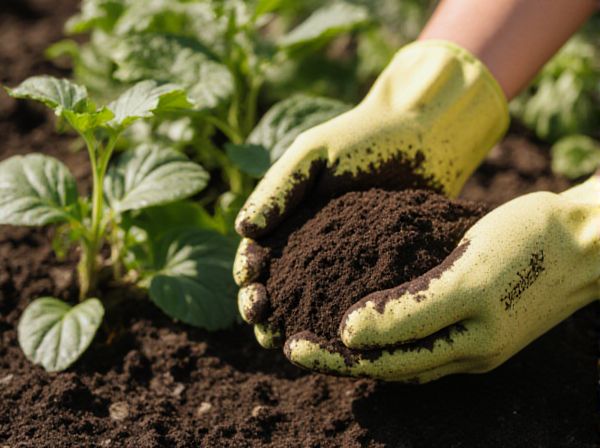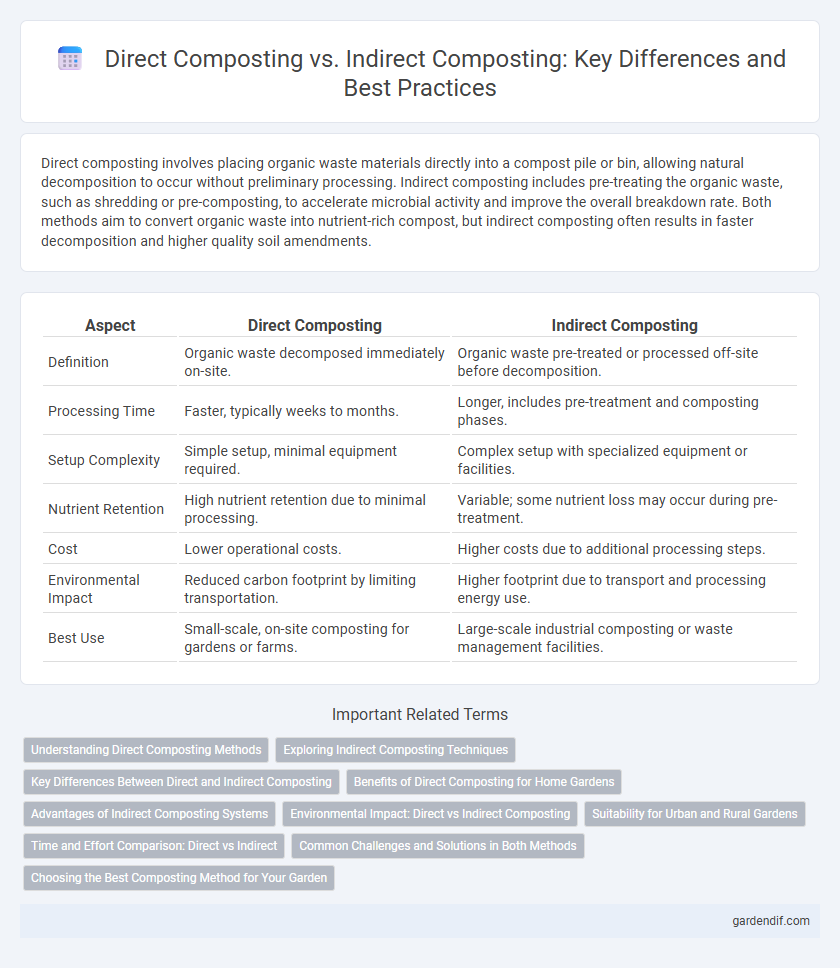
Direct composting vs Indirect composting Illustration
Direct composting involves placing organic waste materials directly into a compost pile or bin, allowing natural decomposition to occur without preliminary processing. Indirect composting includes pre-treating the organic waste, such as shredding or pre-composting, to accelerate microbial activity and improve the overall breakdown rate. Both methods aim to convert organic waste into nutrient-rich compost, but indirect composting often results in faster decomposition and higher quality soil amendments.
Table of Comparison
| Aspect | Direct Composting | Indirect Composting |
|---|---|---|
| Definition | Organic waste decomposed immediately on-site. | Organic waste pre-treated or processed off-site before decomposition. |
| Processing Time | Faster, typically weeks to months. | Longer, includes pre-treatment and composting phases. |
| Setup Complexity | Simple setup, minimal equipment required. | Complex setup with specialized equipment or facilities. |
| Nutrient Retention | High nutrient retention due to minimal processing. | Variable; some nutrient loss may occur during pre-treatment. |
| Cost | Lower operational costs. | Higher costs due to additional processing steps. |
| Environmental Impact | Reduced carbon footprint by limiting transportation. | Higher footprint due to transport and processing energy use. |
| Best Use | Small-scale, on-site composting for gardens or farms. | Large-scale industrial composting or waste management facilities. |
Understanding Direct Composting Methods
Direct composting involves the immediate layering of organic waste materials like kitchen scraps, yard trimmings, and manure into a compost pile or bin, facilitating rapid microbial decomposition. This method promotes efficient aeration and moisture control by regularly turning or mixing the pile to optimize conditions for aerobic bacteria and fungi. It contrasts with indirect composting, which often requires pre-processing or composting in separate phases before combining materials.
Exploring Indirect Composting Techniques
Indirect composting techniques involve creating optimal conditions for microbial activity by regulating temperature, moisture, and aeration without direct handling of the compost pile. Methods such as vermicomposting utilize earthworms to accelerate decomposition, while bokashi fermentation relies on anaerobic microbial inoculants to break down organic matter efficiently. These approaches enhance nutrient retention and reduce greenhouse gas emissions compared to traditional direct composting.
Key Differences Between Direct and Indirect Composting
Direct composting involves the immediate breakdown of organic waste in a controlled environment, promoting rapid microbial activity and faster nutrient cycling. Indirect composting relies on an intermediary process, such as vermicomposting or the use of composting bins, which moderates temperature and moisture levels for gradual decomposition. Key differences include the rate of decomposition, microbial diversity, and suitability for various types of organic materials.
Benefits of Direct Composting for Home Gardens
Direct composting in home gardens enhances nutrient retention by allowing organic waste to decompose precisely where plants grow, improving soil fertility and structure. This method reduces labor and transportation costs, making it an efficient, eco-friendly solution that minimizes carbon footprint. Moreover, direct composting fosters beneficial microbial activity, boosting plant health and resilience against pests and diseases.
Advantages of Indirect Composting Systems
Indirect composting systems enhance compost quality by allowing better control over temperature, moisture, and aeration, resulting in more efficient decomposition and pathogen reduction. These systems enable separation of composting phases, minimizing odor production and pest attraction compared to direct composting methods. The controlled environment of indirect composting also accelerates nutrient stabilization, producing a more consistent and nutrient-rich final product.
Environmental Impact: Direct vs Indirect Composting
Direct composting reduces greenhouse gas emissions by allowing organic waste to decompose aerobically on-site, minimizing methane production typically associated with anaerobic conditions. Indirect composting often involves transporting organic materials to centralized facilities, increasing fossil fuel consumption and carbon emissions due to logistics. Studies show direct composting lowers overall environmental footprint by cutting transportation-related pollutants and enhancing localized nutrient recycling.
Suitability for Urban and Rural Gardens
Direct composting offers an efficient solution for urban gardens where space constraints limit compost pile size, enabling faster decomposition through regular turning and layering of organic waste. Indirect composting suits rural gardens by utilizing larger, static compost heaps or windrows that accommodate higher volumes of diverse organic materials, promoting nutrient-rich humus over extended periods. Both methods support sustainable soil enrichment but differ in scale and maintenance suited to urban compactness or rural abundance.
Time and Effort Comparison: Direct vs Indirect
Direct composting typically requires less time and effort since organic waste is added straight to the compost pile or bin, accelerating decomposition through immediate microbial activity. Indirect composting involves pre-treating organic materials, such as shredding or fermenting, which demands additional labor and extends preparation time but can enhance compost quality and nutrient availability. Overall, direct composting offers a quicker, low-maintenance option, while indirect methods invest more effort upfront for potentially richer, more stable compost output.
Common Challenges and Solutions in Both Methods
Direct composting often faces challenges such as uneven decomposition and odor control, whereas indirect composting struggles with managing transportation and transfer of organic materials. Both methods encounter common issues like maintaining optimal moisture levels and ensuring proper aeration to promote microbial activity. Solutions include regular turning or mixing, monitoring temperature, and using bulking agents to improve structure and airflow.
Choosing the Best Composting Method for Your Garden
Direct composting involves placing organic materials directly into the soil to decompose in place, promoting immediate nutrient release and soil improvement. Indirect composting requires creating a separate compost pile or bin where organic waste breaks down before being applied to the garden, allowing for controlled decomposition and pathogen reduction. Selecting the best method depends on garden size, waste volume, and desired nutrient availability, with direct composting suited for smaller gardens and indirect composting ideal for larger spaces and efficient waste management.
Direct composting vs Indirect composting Infographic

 gardendif.com
gardendif.com